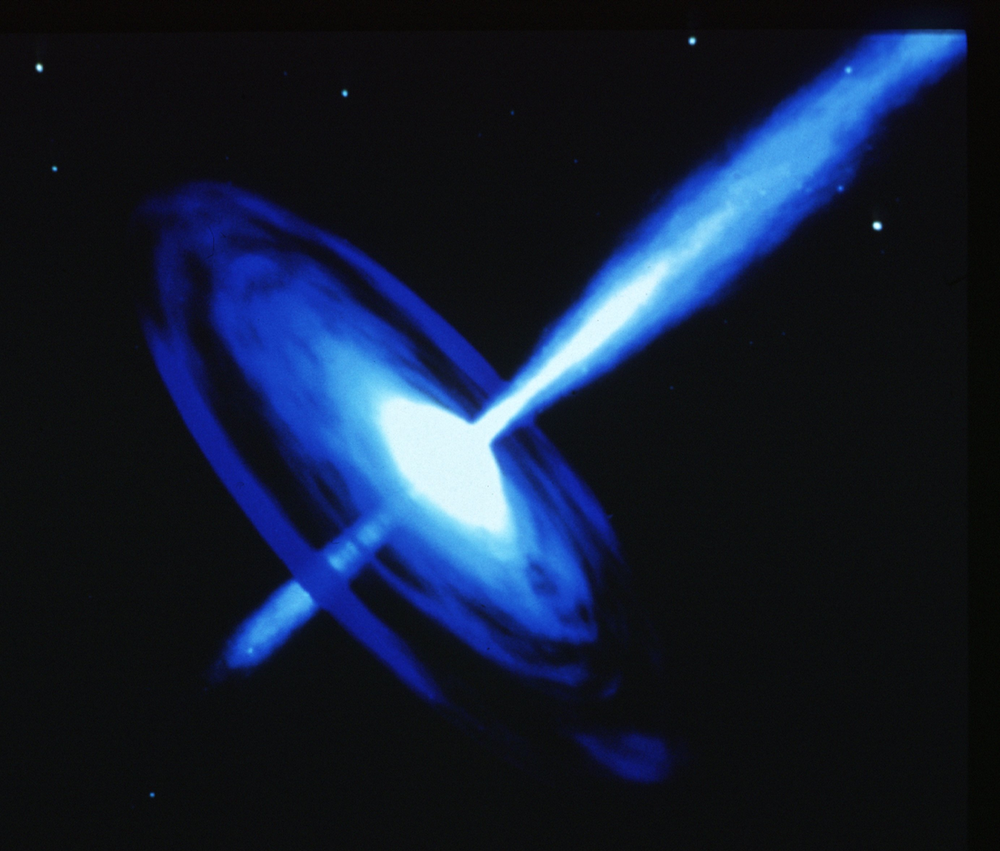Landmarks—The Curved Space around a Spinning Black Hole
Landmarks articles feature important papers from the archives of the Physical Review journals.
General relativity describes how mass and energy induce curvature in spacetime. The math is intricate, so exact solutions to Einstein’s equations are rare. One important solution appeared in Physical Review Letters in 1963. Analysis over the following years showed it to be the unique description of curved spacetime around a spinning black hole. Since all black holes spin, this solution has been essential to astrophysicists studying the behavior of black holes and of matter in their vicinity.
Solutions to Einstein’s general relativity equations describe the curvature of space with a mathematical function called the metric tensor, or “metric.” Given the coordinates of two points in space, the metric tells you how to compute the distance between them, since the usual Pythagorean theorem doesn’t apply in curved space. On the surface of a sphere, for example, the Pythagorean answer is always too small.
Einstein published his theory of gravitation in 1916. That same year, the German mathematical physicist Karl Schwarzschild found a spherically symmetric solution for empty space, with no time variation but with curvature everywhere. Mathematicians eventually showed that Schwarzschild’s metric had a central singularity—corresponding to a finite mass packed into a point—and a surrounding spherical surface called the “event horizon” at what became known as the Schwarzschild radius. This metric is now known as the description of a static black hole (see 2004 Focus Landmark).
In 1918 theorists used approximate methods to show that a rotating mass also distorts spacetime via an effect called frame dragging [1]. An example is that bodies traveling around the Earth on identical orbits, but in opposite directions, will measure slightly different times for one circuit. A complete solution to the Einstein equations for a rotating body would have the symmetry of a cylinder, but even this modest departure from spherical symmetry made solving the equations fearsomely difficult.
Roy Kerr, a New Zealand relativist at the University of Texas in Austin and Wright-Patterson Air Force Base in Ohio, came at the problem from a different angle. Exploring a certain class of metrics, he found an exact solution with two free parameters. One corresponded to the mass parameter in the Schwarzschild metric, but the significance of the other was not obvious. By examining the form of the new solution at large distances from the origin and by comparing it to known, approximate solutions for a rotating object, Kerr showed that the second parameter represented angular momentum—essentially, the amount of spin [2].
The Kerr metric was clearly a description of spacetime curvature around a spinning mass. But interpreting the physical significance of some mathematical oddities close to the origin proved difficult. Whereas the Schwarzschild metric has a central point singularity, the Kerr metric has a singularity that looks like “a ring in the equatorial plane … spinning at the speed of light,” explains Werner Israel of the University of Victoria, Canada. In addition, the Kerr metric possesses two surfaces that looked like event horizons, with one nested inside the other but touching at the poles. Robert Wald of the University of Chicago says that the meaning of these surfaces was “not clear from the Kerr metric written in Kerr’s coordinates.”
A few years later, analyses showed that only the inner surface is a true event horizon, and that the smaller ring singularity is not accessible to the world outside [3]. The outer surface defines a region within which frame-dragging is so powerful that even light can only orbit in one direction. That opened the way for interpretation of the Kerr metric as a description of a spinning black hole, but it wasn’t the end of the story. The Kerr metric has just two parameters, mass and angular momentum, but astrophysical objects, Israel says, have “different oblateness, bumps, and other deformities” that the Kerr metric cannot account for.
Studies by a number of physicists in the 1970s resolved this point by proving what was called the “no hair” theorem. Any rotating object, as it collapses into a black hole, emits gravitational radiation that erases all of its irregularities, so that mass and angular momentum are its only surviving characteristics (along with electric charge, if there is any). Israel cites the Nobel laureate S. Chandrasekhar, who said that in his entire scientific life, “the most shattering experience has been the realization that [the Kerr metric] provides the absolutely exact representation of untold numbers of massive black holes that populate the Universe.” [4]
–David Lindley
David Lindley is a freelance science writer, now retired. His most recent book is The Dream Universe: How Fundamental Physics Lost Its Way (Penguin Random House, 2020).
References
- J. Lense and H. Thirring, “Über den Einfluss der Eigenrotation der Zentralkörper auf die Bewegung der Planeten und Monde nach der Einsteinschen Relativitätstheorie,” Phys. Zeitschr. 19, 156 (1918)
- In “Discovering the Kerr and Kerr-Schild metrics,” a 2008 memoir available at arXiv:0706.1109, Kerr gives a detailed account of the mathematical arguments that led to his discovery
- R. H. Boyer and R. W. Lindquist, “Maximal Analytic Extension of the Kerr Metric,” J. Math. Phys. 8, 265 (1967); B. Carter, “Global Structure of the Kerr family of Gravitational Fields,” Phys. Rev. 5, 1559 (1968)
- S. Chandrasekhar, Truth and Beauty (University of Chicago Press, Chicago, 1987) p. 54 [Amazon][WorldCat]





